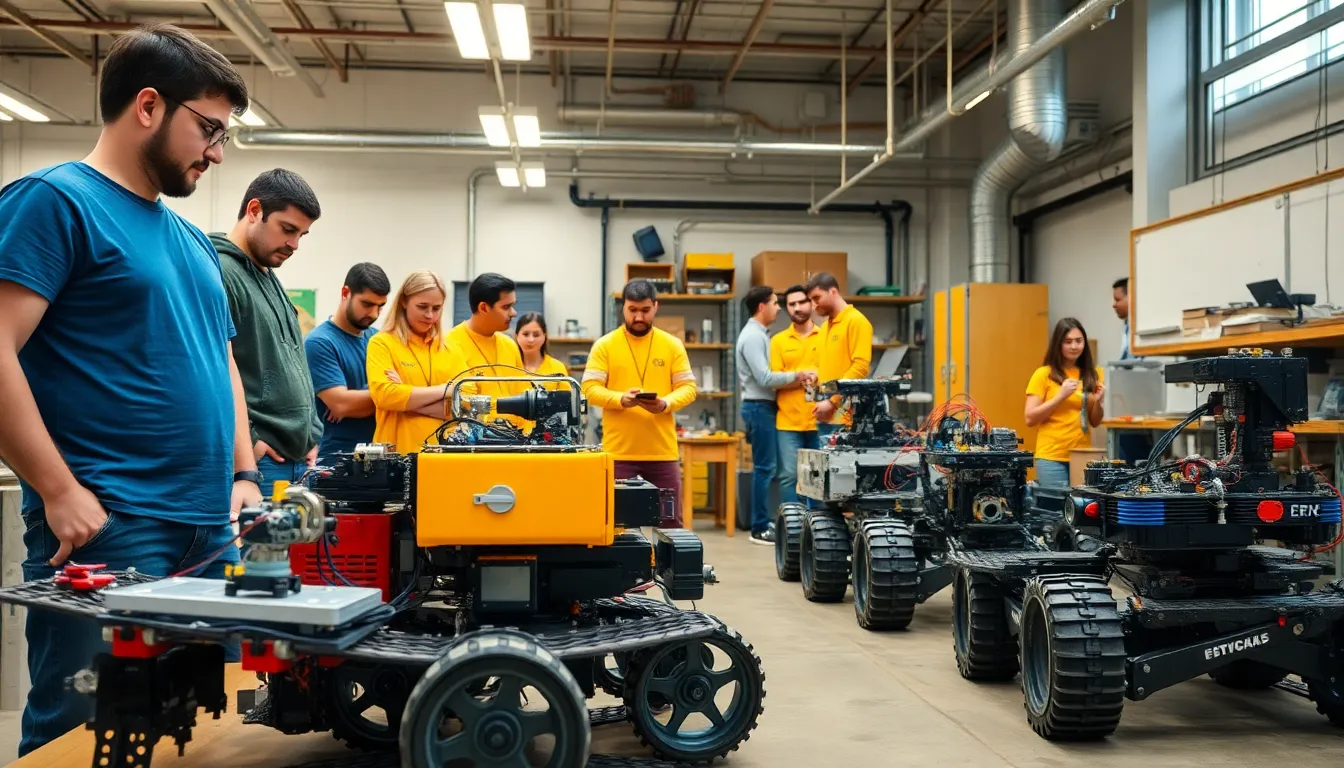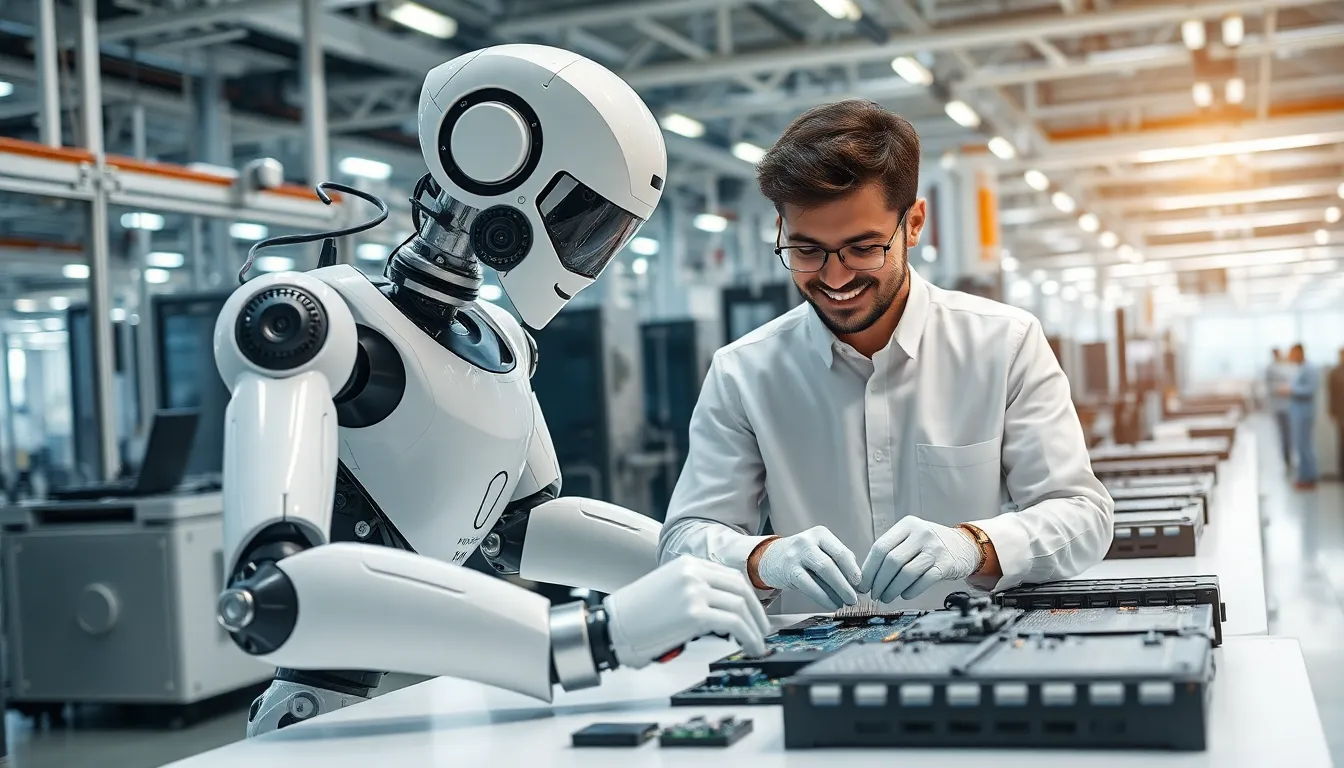In a world increasingly driven by technology, robotics platforms are revolutionizing industries and everyday life. These versatile systems serve as the backbone for a wide range of applications, from manufacturing automation to healthcare innovations. As businesses seek efficiency and precision, understanding the capabilities and types of robotics platforms becomes essential.
Robotics platforms combine hardware and software to create intelligent machines that can perform complex tasks. They not only enhance productivity but also open new avenues for research and development. As advancements continue to emerge, exploring the landscape of robotics platforms reveals exciting possibilities that could shape the future of work and human interaction.
Table of Contents
ToggleOverview of Robotics Platforms
Robotics platforms represent integrated systems combining hardware and software to perform complex tasks. Their significance spans multiple sectors, enhancing efficiency and transforming operational workflows.
Definition and Significance
Robotics platforms refer to the foundational technologies enabling robots to perform specific functions. They typically include a combination of sensors, actuators, computing units, and software interfaces. The significance lies in their capability to automate tasks, reduce human error, and increase productivity across industries like manufacturing, logistics, and healthcare. These platforms serve as the basis for advancements in automation, driving innovation and enabling businesses to achieve higher precision and consistency in operations.
Types of Robotics Platforms
Various types of robotics platforms cater to different applications. Some examples include:
- Industrial Robots: Designed for manufacturing tasks such as welding, assembly, and painting, these robots enhance production efficiency.
- Collaborative Robots (Cobots): Safe to work alongside humans, cobots assist in various tasks, promoting teamwork in work environments.
- Mobile Robots: These platforms navigate through environments autonomously, often used in warehouses and delivery systems.
- Service Robots: Implemented in healthcare and hospitality, these robots assist with tasks like patient care and customer service.
- Research Robots: Employed in laboratories and educational institutions, research robots facilitate experimentation and technological advancements.
Each platform addresses specific needs, demonstrating the versatility and adaptability of robotics in various fields.
Key Features of Robotics Platforms

Robotics platforms incorporate several key features that enhance their functionality and effectiveness across various applications. Understanding these features is crucial for businesses aiming to leverage robotics technology.
Mobility and Navigation
Mobility and navigation define a robotics platform’s ability to move within its environment, allowing efficient operation. Different mobility types exist, including wheeled, tracked, and legged robots. For example, wheeled robots excel in flat, indoor environments, while tracked robots suit rough terrains. Advanced navigation techniques, such as localization and mapping algorithms, enable robots to understand their surroundings, facilitating autonomous movement. Integration of GPS technology ensures outdoor robots maintain accurate positioning.
Sensor Integration
Sensor integration enhances the perception of robotics platforms, enabling them to interact safely and effectively with their environment. Various sensor types, including lidar, ultrasound, and cameras, provide critical data about surroundings. Lidar sensors, for instance, deliver precise distance measurements, aiding in obstacle detection and navigation. Cameras facilitate image recognition and processing, allowing robots to identify objects and interpret visual data. This integrated sensory feedback supports real-time decision-making, improving operational efficiency.
Control Systems
Control systems manage the operations of robotics platforms, determining how they execute tasks and respond to real-time inputs. Various control architectures exist, such as centralized and decentralized systems. Centralized control systems centralize decision-making, allowing uniform command execution across multiple robots. In contrast, decentralized systems enable each robot to make autonomous decisions, improving adaptability. Sophisticated algorithms, including machine learning and reinforcement learning, enhance control systems, supporting complex task execution and fostering continuous improvement through adaptive learning.
Applications of Robotics Platforms
Robotics platforms find extensive applications across various sectors, driving innovation and enhancing productivity. Their capabilities enable significant advancements in industrial use, medical robotics, and research and development.
Industrial Use
Industrial robots automate tasks in manufacturing, assembly, and packaging. They increase output, cut labor costs, and enhance precision. Common applications include:
- Welding: Robots perform high-precision welding in automotive assembly lines.
- Material Handling: Robots transport heavy materials, improving efficiency and reducing workplace injuries.
- Quality Control: Robots equipped with sensors conduct inspections and ensure product quality, minimizing defects.
Medical Robotics
Medical robotics revolutionize healthcare processes and patient care. They assist in surgeries, rehabilitation, and patient monitoring. Key applications include:
- Surgical Robots: Systems like the da Vinci Surgical System enable minimally invasive surgeries with enhanced precision.
- Rehabilitation Robots: Exoskeletons aid patients in physical recovery, promoting mobility and independence.
- Telepresence Robots: Robots facilitate remote consultations, allowing healthcare professionals to engage with patients from various locations.
Research and Development
- Prototyping: Robots assist in rapid prototyping, allowing for the quick development of new products and concepts.
- Environmental Monitoring: Robots gather data in challenging terrains, supporting research in areas like climate change and ecosystem health.
- Artificial Intelligence: Robots help test AI algorithms, refining their learning and adaptability through real-world applications.
Leading Robotics Platforms in the Market
Numerous robotics platforms drive innovation across industries. These platforms vary significantly in capabilities and applications, showcasing their adaptability to different demands.
Platform Comparisons
| Platform Name | Type | Key Features | Industries Served |
|---|---|---|---|
| ABB IRB 6700 | Industrial Robot | High payload, precision control | Manufacturing, Automotive |
| Universal Robots UR3 | Collaborative Robot | Lightweight, easy programming | Manufacturing, SMBs |
| Boston Dynamics Spot | Mobile Robot | Agile navigation, advanced sensors | Construction, Security |
| iRobot Roomba | Service Robot | Autonomous navigation, smart mapping | Household, Hospitality |
| KUKA LBR iiwa | Collaborative Robot | Sensory technology, safe human-robot interaction | Manufacturing, Healthcare |
Leading platforms include ABB IRB 6700, known for its high payload in manufacturing, and Universal Robots UR3, emphasizing user-friendly programming for small and medium businesses. Boston Dynamics Spot provides unmatched mobility and sensor integration for diverse applications, while iRobot Roomba excels in household environments with its autonomous capabilities. KUKA LBR iiwa features advanced sensory technologies, ensuring safety in human-robot collaboration, particularly in healthcare.
Emerging Technologies
Emerging technologies drastically enhance robotics platforms.
- Artificial Intelligence (AI): AI enables robots to learn from their environments, automating complex tasks and improving decision-making.
- Machine Learning: Machine learning algorithms allow robots to adapt to new situations without human intervention, increasing efficiency.
- 5G Connectivity: 5G networks enhance communication speed and reliability, permitting real-time data transfer for autonomous robots.
- Extended Reality (XR): XR technologies, such as augmented reality (AR) and virtual reality (VR), improve operator training and robot interaction.
- Advanced Sensors: New sensors, like 3D imaging cameras and Lidar, enhance environment perception, allowing robots to navigate complex spaces accurately.
These technologies push the boundaries of robotics, propelling advancements in automation, efficiency, and safety across various sectors.
Future Trends in Robotics Platforms
Robotics platforms continue to evolve rapidly, driven by technological advancements and growing market demands. Emerging trends indicate significant innovations and challenges on the horizon.
Innovations to Watch
- Artificial Intelligence Integration: AI enhances robotics capabilities, enabling platforms to learn from data and improve task performance over time.
- Collaborative Robotics: Cobots are designed for safe interaction with humans, fostering teamwork in various operational settings and optimizing productivity.
- Autonomous Mobility: Developments in navigation algorithms lead to improved autonomous decision-making, allowing robots to navigate complex environments seamlessly.
- Modular Platforms: Modular designs offer flexibility, allowing businesses to customize robotics systems according to specific operational needs and easily replace components.
- Advanced Sensors: Innovations in sensor technology enhance environmental awareness, enabling robots to perform more complex tasks with higher precision in real-time.
Challenges and Opportunities
- Regulatory Hurdles: Compliance with safety regulations may slow the integration of robotics platforms into certain industries, creating barriers for innovation.
- Workforce Transition: As robots become more prevalent, workforce retraining will become essential to equip employees with the skills to work alongside advanced platforms.
- Cybersecurity Risks: Increased connectivity raises concerns over data security, necessitating robust cybersecurity measures to protect robotic systems from potential threats.
- Market Competition: The rapid advancement of technology leads to a saturated market, compelling companies to innovate continuously to maintain competitive advantages.
- Investment in R&D: Increased funding in research and development presents opportunities for breakthroughs, driving advancements in robotics capabilities and applications across sectors.
Robotics platforms are reshaping industries and enhancing everyday life through their diverse applications and innovative features. As businesses embrace these technologies, the focus on efficiency and productivity becomes paramount. The versatility of robotics platforms allows them to adapt to various tasks across sectors, from manufacturing to healthcare.
Looking ahead, advancements in artificial intelligence and sensor technology will continue to push the boundaries of what robots can achieve. While challenges remain, the commitment to research and development will pave the way for groundbreaking solutions. The future of robotics is bright and promises to transform how work is done and how humans interact with technology.




